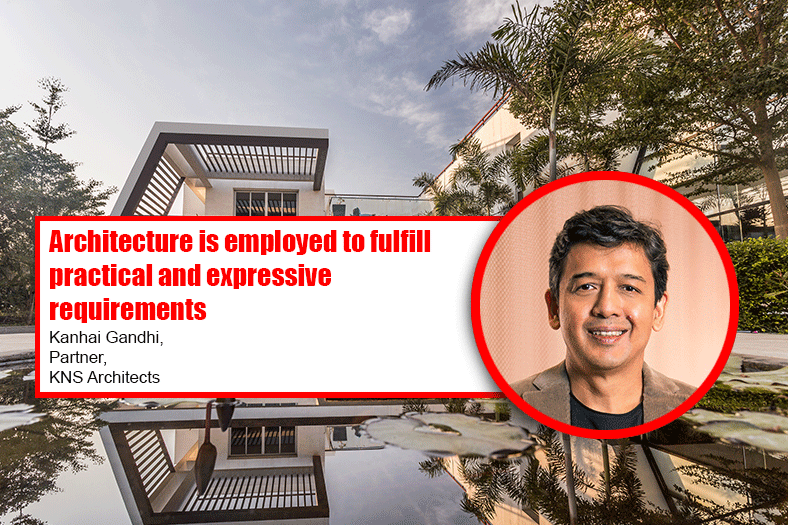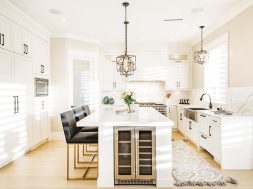Architecture is employed to fulfill practical and expressive requirements

Architecture is a form of expression of thought and as a thought; it has been there from the beginning of human civilization. It also serves both utilitarian and aesthetic ends. The main purpose of architecture is to provide shelter, and mankind has been developing it for centuries says Kanhai Gandhi, Partner, KNS Architects.
As one of the well-known professionals in the field of architecture and design, how do you believe the profession has evolved over the years?
We have seen a drastic change from the time we began our practice. The entire dynamics of design have changed, with the world opening up, awareness accessibility and availability have transformed drastically.
The awareness has increased within the client along with us because of the easy travel. Along with the IT boom and the advancement in technology has made work and life even simpler yet more competitive. The company got its first computer in the late 90s. AutoCAD had just started to become aware amongst the users. This revolution had just begun then, to now everything is easily available with just a click. This definitely has been a boon because it always keeps you on your toes; you are constantly learning, adapting and updating yourself.
The design process has also improved and become much advanced. Over the last two decades, the Indian architects are is constantly proving their mettle in the global arena and making a mark across globe with their body of work. We are regaining our position as trendsetters and not just organised project managers.
Do you feel architecture is a discourse much beyond form and function alone?
Architecture is the art and technique of designing and building, as distinguished from the skills associated with construction. The practice of architecture is employed to fulfill both practical and expressive requirements and thus it serves both utilitarian and aesthetic ends.
Architecture as a thought has been there from the beginning of human civilization. The main purpose of architecture is to provide shelter and mankind has been developing it for centuries. Apart from providing shelter architecture is also an expression of values – the way we build is a reflection of the way we live. This is why vernacular traditions and the historical layers of a city are so fascinating, as every era produces its own vocabulary. Sometimes we have to explore the past to find inspiration for the future. The exact origin of architecture dates back to the Neolithic period, around 10,000 BC or simply when people stopped living in caves and started handling the way they want their houses to look and feel like.
From treehouses, caves, mud houses, buildings to skyscrapers architecture has been evolving and it is beyond just form and function. It has helped in developing the cultural outlook of the society. Architecture is much more than what meets one’s eye. It just doesn’t transform the visual look of a place/area (the form) it brings in a social/cultural context to the society. Architecture in a true sense is an embodiment of our civic values.
Do you feel the pandemic has altered the way architecture and more precisely interior design is perceived, what kind of changes will be visible in the future projects from now on?
This pandemic has made us realize a lot of things. Living together and getting the “me time” was the thing that could get us going through the days. Man is a social animal and living together is what humans want. But along with that, some space for isolation where one can get to do anything one desires has become very essential.
From the vintage heritage buildings which have witnessed the evolution of generations to the new age buildings, which are some creations in the built environment you adore?
Conservation of heritage buildings is very important because it provides a sense of identity and continuity in a fast-changing world for future generations. Heritage buildings represent the history and culture of a nation. We are experiencing a general increase in the awareness of the social value of buildings in the built environment. Owing to this the adaptive reuse of the existing built fabric is becoming more and more prevalent in Western Europe. This is not only a response to a growing awareness of the cultural importance of built fabric but also a response to the ecological impacts of the construction process within a wider understanding of sustainability
In some of the heritage buildings which exists till date have past building styles and present are merged together, creating a seamless transition. One such example is the Le Louvre. The Louvre was constructed in a span of over three hundred years exemplifying traditional French architecture since the Renaissance.
The Louvre is the world’s largest museum and houses one of the most impressive art collections in history. The magnificent, baroque-style palace and museum — LeMusée du Louvre in French — sits along the banks of the Seine River in Paris. It is one of the city’s biggest tourist attractions. Like many buildings, it was built and rebuilt over the years. In 1983, the Louvre underwent a renovation plan known as the Grand Louvre (Louvre Pyramid).
The entirety of the project, known as the Grand Louvre, was executed in two phases over the course of a decade. For the first phase, which gave rise to the pyramid, Pei reorganized the museum around the central courtyard, the Cour Napoléon, transforming it from a parking lot to one of the world’s great public spaces. It is a perfect example of ‘Combining traditional style with modern architecture, it shows the Louvre’s timeless beauty.’ “
Do you feel there is a lot to learn especially from the heritage buildings, more so, because they have redefined their robustness, utility whilst maintaining their aesthetics in the current timeline?
The architecture of a place defines the character of the city. It gives one the essence of the city. The country’s rich architectural heritage isn’t limited to a building. It represents our history, identity and our bond with the past, present and the future.
The architecture of a place like Rajasthan would be different from the architecture of a city like Mumbai. Apart from the climatic response that would bring the change in the design of structures, it is also the social and cultural aspects of the city that is defined by its architecture. Heritage structures help one in understanding these finer aspects.
For an architect, it is quite astounding to see these structures standing strong with the use of minimal technology that was available. Not only are the designs sturdy, the precision in terms of proportions and elements is also worth exploring. In an era of globalization, heritage architecture also helps us to remember our cultural diversity, and helps in fostering mutual respect amongst different cultures.
What kind of building design do you feel is apt for a country like India which is populous as also climatically diverse?
The human race It is growing at an exponential and uncontrollable rate over the years. This has raised real concern about the availability of habitable land. The habitable land can be the land that we live on as also the one that helps us live (land for growing food). With the ever-increasing population the availability of habitable land poses a major crisis.
In 2020, we are close to eight billion and might touch 10 or more in just a few years at the rate at which it is growing. The globe mass ratio of water and land is with an abundance of seas and oceans, the landmass is way lower and that too limited, with respect to being resourceful and habitable, a major chunk is inhabitable like deserts, poles etc.
Certain areas like forests have to be conserved as they are the main resources to create an ecological balance. The remainder i.e. for living and agricultural is limited and very precious, an invaluable commodity!! The architecture of India is broadly classified as rural architecture and urban architecture. Rural architecture mostly spreads in the horizontal direction and the urban architecture adds to the city skyline going vertical.
In the urban context, it would be like tall trees, the high rises and tier up at the same time growing vertical that would create more landmass as it stacks up vertically. Emphasis is to create land, with zero footprint and to generate resources rather than deplete it. As it is less strenuous on the existing infrastructure or developing new ones and wasting energies towards the same and idea is to generate the valuable land and grow vertical
Biophilic architecture can address this issue to an extent. Biophilic design is an approach to architecture that seeks to connect building occupants more closely to nature. Biophilic designed buildings incorporate things like natural lighting and ventilation, natural landscape features and other elements for creating a more productive and healthy built environment for people.
Cookie Consent
We use cookies to personalize your experience. By continuing to visit this website you agree to our Terms & Conditions, Privacy Policy and Cookie Policy.









